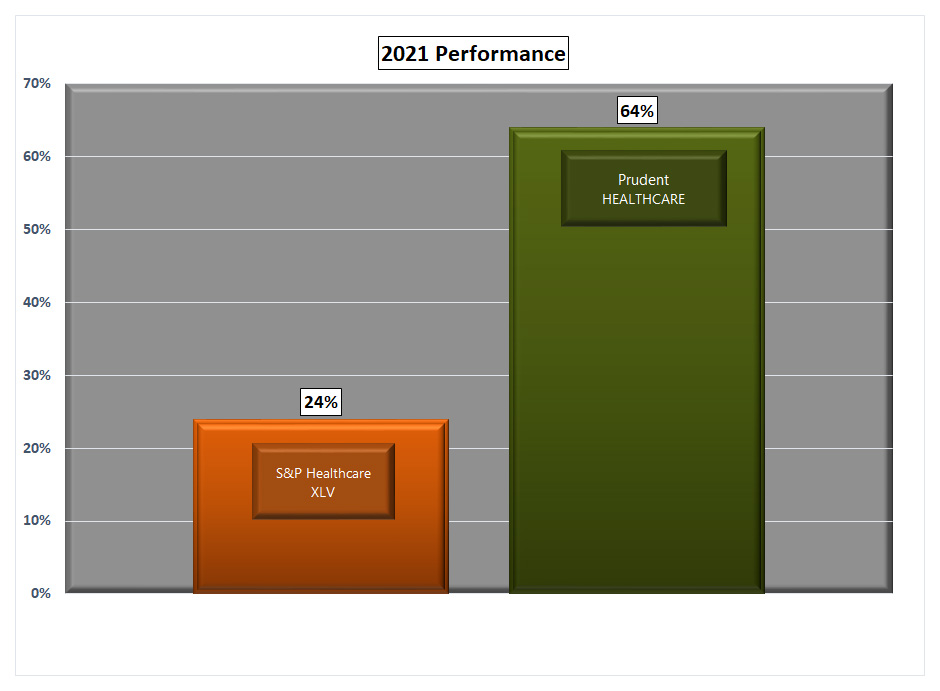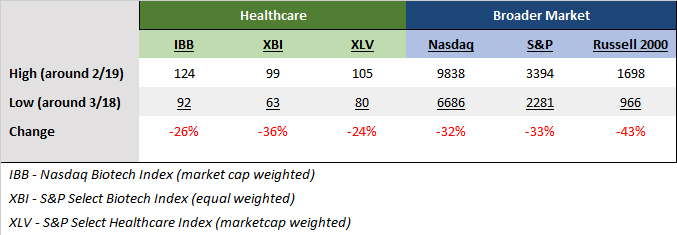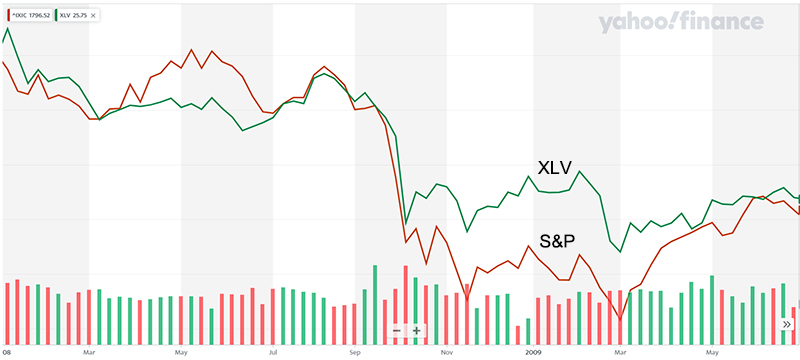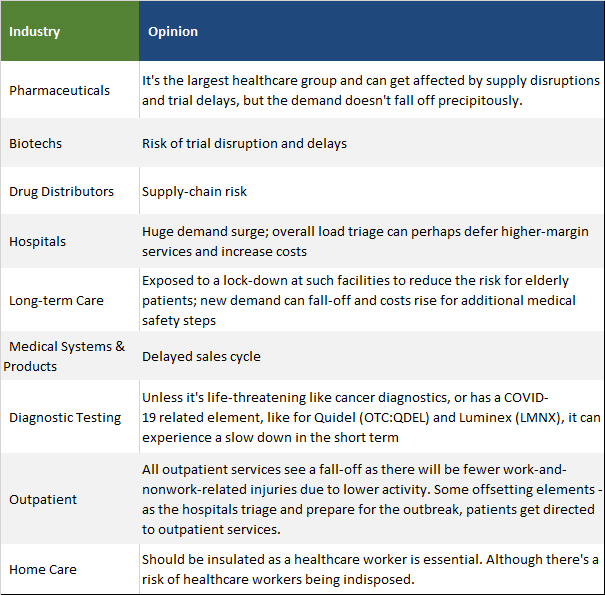Healthcare Pulse
The healthcare sector has been in the thick of the pandemic response over the past two years in restoring lives and livelihoods. In 2021, the healthcare sector (NYSEARCA:XLV) lagged the broader market in the first quarter and built up momentum over the final months, closing the year with a gain of 24%, not too far behind the broader market performance of the S&P 500 index. The Prudent Healthcare model portfolio gained 64% during 2021.
The healthcare sector's performance was quite robust when considering the material underperformance of one of its key groups, biotechnology (XBI), which fell over 20%.
Spending Trends Continue To Favor Healthcare
Healthcare has played a pivotal role in managing and recovering from the coronavirus pandemic and there will likely be ongoing multi-billion revenue streams around vaccines, treatments, hospital care, etc., for years. However, going forward healthcare will be a beneficiary of pent-up demand for services and overarching favorable trends that will ensure long-term growth in healthcare spending.
Healthcare spending has grown to one-fifth of US GDP. It grew nearly 10% in 2020 to over $4 trillion, as per the Centers for Medicare & Medicaid Services or CMS. As the year matures and the pandemic is transformed into an endemic with broader vaccination and availability of easier treatments, the healthcare system will continue its rapid journey towards normalcy. The entire healthcare system covering hospital-related ecosystem, life sciences, medical services, medical devices and systems, amongst others, will benefit. Many elective services have witnessed a demand deferral, and will rapidly begin to flow into the healthcare system.
The aging of America continues and that increases healthcare spending. The administration has focused on expanding healthcare services and access, and although the recent Build Back Better bill got grounded, a modified version may yet emerge with significant spending on healthcare initiatives.
The power of Federal spending in fighting back the pandemic has highlighted the government's indispensable role in healthcare. The Federal government spending on health care grew sharply by 36.0% in 2020, due to the pandemic response, much higher than the ~6% growth rate in 2019. That growth will ease back in 2022, but likely not decline as the funding will be rotated to new initiatives.
Government funding for life sciences research is going to keep increasing, and the pandemic has ensured higher budgets for CDC and NIH, which provides billions of research dollars to smaller life science companies. Billions of research dollars will be allocated for moonshot outcomes as well, particularly in oncology, where a cure for cancer has long been a personal goal of President Biden, and for Alzheimer's disease, the scourge on an aging America. The public-private partnership model that delivered vaccines and treatments for the pandemic should now be applied at scale to finding cures for major diseases.
Biotechs and Pharmaceuticals (Biopharma)
Biotechs represent the high-risk and high-reward speculative segment of healthcare. As noted in the 2022 Biotech Outlook, life science is advancing at a rapid pace with new ideas, new approaches, and new technologies. The pace of breakthrough innovation will continue. However, biotech stocks will face a challenging first half as rising interest rates and an unsettled pace of increases will create a risk-off market for speculative segments. As discussed in the outlook, biotechs should perform relatively better in the second quarter, and each subsequent quarter of this year thereafter.
Pharmaceuticals will benefit from the defensive nature of the industry in a volatile climate. There is also a relatively much lower risk of structural regulatory changes now, particularly around drug pricing. Expansion of healthcare being envisioned in the Build Back Better bill will provide an additional boost, particularly to pharmaceuticals, medical devices, and services companies.
Medical Services, Devices, and Systems
The country spends over $4 trillion annually on healthcare. Of this amount, McKinsey estimates nearly one-quarter of the spending, or one trillion dollars, is related to administrative spending and the remaining three-quarters to care delivery. The healthcare system has thousands of players. There are over 6,000 hospitals, over 136,000 physician groups of five or more doctors, and over 900 payers. The fee-for-service payment model puts competitive checks and balances on payers, hospitals, and physician groups. The fragmentation and regulation create a significant administrative burden on the system and triggers unnecessary spending due to multiple transaction points. There is a significant opportunity to streamline the processes and reduce the errors and inefficiencies that build up in layers of spending. McKinsey believes nearly a quarter-trillion dollars of administrative savings can be possible through structural changes, more efficient process management, and improving the productivity of healthcare delivery. Technology initiatives and digitization will be key enablers.
Payers that can improve productivity and efficiencies will stand out. Medical services companies that provide solutions for driving productivity growth and savings will remain well-positioned and continue to do well even in a rising interest rate environment.
Above is just one opportunity. Healthcare technology spending on productivity and innovation initiatives will grow as the pressure of COVID-19 related spending subsides and hospital capacity becomes available for non-COVID healthcare. The advancements in technology continue to expand the opportunities for Medtech companies engaged in unlocking the value of emerging technologies for healthcare. Pharmaceutical and life-science companies are realizing the potential of cloud computing in enabling data analytics, unprecedented scaling, driving productivity and innovation, utilizing AI, and shrinking time-to-market. Moderna's (MRNA) rapid vaccine development was underpinned by cloud technology, and as Stéphane Bancel, CEO, pointed out in 2020, “Because you don’t have to reinvent anything. You just fly.”
While high-growth companies with high P/E multiple will be adversely affected in the near term due to a rising and uncertain interest rate policy, the services companies with recurring revenues and emerging growth opportunities will outperform.
Regulatory Environment and Inflation Risk
The regulatory environment is relatively more benign than it was at the same time last year. A push for pricing regulation and bargaining power for the Centers for Medicare & Medicaid Services has been significantly eroded in the Build Back Better bill and maybe further diluted down in ongoing negotiations in Congress.
Healthcare inflation has nearly always been ahead of general consumer inflation in the last thirty years, but this year is a different story. Healthcare costs have risen 6 percent each year this century, as per the Kaiser Family Foundation. So the general inflation spike takes the focus off healthcare inflation for now to some extent, but it won't be long before healthcare costs also begin to reflect the supply constraints being experienced by the broader economy. Nursing shortage and healthcare professional burnout are quite well-documented. The imbalances will result in requests for higher reimbursement rates and higher costs being passed on by payers to employers and patients.
Pharmaceutical companies typically raise drug prices in January and July each year. This year January increases paced at an average of 5%, compared to last year's 4.6%, as per GoodRx (GDRX).
Segments of healthcare that may not be able to raise prices sufficiently can experience margin erosion. These can be companies with a relatively higher fixed cost base, like hospitals. Healthcare providers will have to aggressively seek opportunities to improve productivity and realign cost structures to tackle healthcare inflation that can become more pronounced as the year progresses.
The healthcare industry is not facing any serious regulatory risks this year although rising drug costs are not an issue that pharmaceuticals will continue to be able to walk away from in the future.
Outlook
There is much to celebrate in how rapidly and extensively healthcare has served the country during the pandemic, and at the same time, there's much to address, fix, and catch up on while applying the lessons learned from the pandemic. All this creates market opportunities.
Healthcare holds significant promise for investors. It is well-positioned for the present volatile environment. The defensive nature of the sector is helpful in a highly unsettled interest rate climate made worse with mounting geopolitical risks. Nonetheless, investors have to be selective in healthcare and initially avoid or limit exposure to its higher-risk segments. A portfolio incorporating companies from the medical services, devices, pharma, payers, and drug distributor groups, amongst others, should perform better than the benchmark S&P Healthcare Index. Biotech companies can be added over time as the interest rate risk stabilizes.
We believe healthcare, even with a drag from biotechnology, will keep pace with the broader market as represented by the S&P 500, and perhaps outpace it once the drag dissipates. For the year, we anticipate the S&P Healthcare Index to rise 5% to 15%, with higher gains for certain groups within healthcare. Of course, the Fed's inflation targeting strategy will play a vital role in market returns, and our assumption is for 4 quarter-point rate increases this year. This return expectation is simply a general framework and will need to be adjusted if market conditions deviate significantly from current expectations.
There will be a significant pool of promising healthcare companies with a potential for strong gains. A few such companies, some of which may be now or in the past be part of our Prudent Healthcare or the Prudent Biotech model portfolios, include AbbVie (ABBV), Pfizer (PFE), Bristol Myers (BMY), McKesson (MCK), AmerisourceBergen (ABC), Viatris (VTRS), Molina Healthcare (MOH), iRhythm Technologies (IRTC), Centene (CNH), Envista Holdings (NVST), Allscripts Healthcare (MDRX), Lantheus (LNTH), and Nextgen Healthcare (NXGN).




